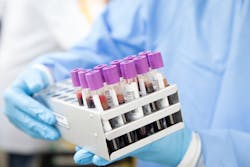Home blood collection device works for COVID antibody test
A device that could make it possible for patients to draw their own blood at home was successfully used to collect blood samples for measuring antibodies against SARS-CoV-2, researchers at the University of Washington School of Medicine found, according to a news release.
The findings suggest the device could be used by patients to draw blood at home for other tests that currently require them to go to a clinic or lab and have blood drawn from a vein, the researchers said.
The study was published online in the journal PLOS ONE.
Participants in the study included 56 people who had previously been infected by SARS-CoV-2 and had recovered. The blood test was to see whether their immune systems had made enough antibodies against the virus that they could donate their antibodies to help treat people with ongoing infections. Thirty-three people without a history of COVID-19, and therefore should not have antibodies to the virus, served as healthy controls.
In this study, researchers used a new device, called the Tasso-SST blood sampling kit, made by Tasso, Inc., a Seattle biotech company.
To collect a blood sample with the Tasso kit, the patient cleans an area on the upper arm and applies the device, which is held in place by an adhesive patch. The patient then pushes a button on the device. This releases a small, spring-loaded lancet that pierces the skin. A vacuum created by the device then gently draws blood through the needle prick from the network of capillary blood vessels that is located just below the skin. The capillary blood flows into a collection tube, which the patient removes, caps, and sends to the lab for analysis. The blood draw typically takes a few minutes.
In the study, the participants’ blood was collected three ways. First, they were given the device kit and written instructions on its use and drew their blood with the device on their own. The device was then used to collect a second sample, this time under the supervision of one of the study staff. And, finally, a phlebotomist drew a sample from a vein using the standard technique.
To mimic the extreme conditions the blood might be exposed to during shipment in the winter and summer, the unsupervised self-collected blood samples were exposed temperatures as low as 14 degrees and has high as 104 degrees Fahrenheit.
All the blood samples were then tested concurrently for the antibodies using the EuroImmun anti-SARS-CoV-2 S1 IgG assay in a Clinical Laboratory Improvement Amendments (CLIA)-certified clinical laboratory, an exacting standard.
The researchers report they found no significant differences between the samples collected by the three different ways.



